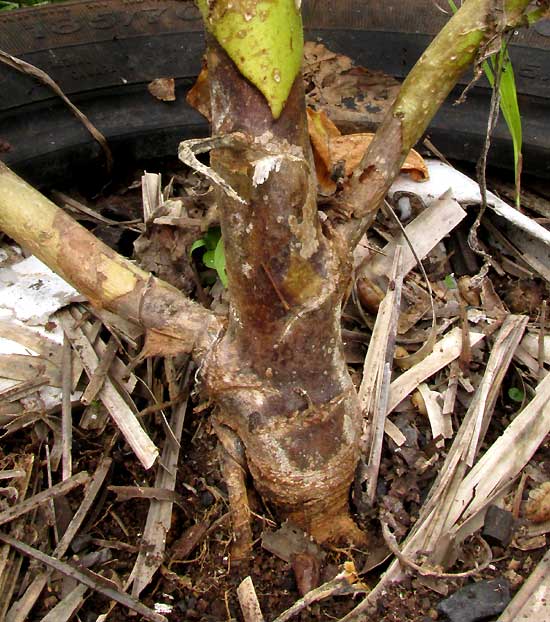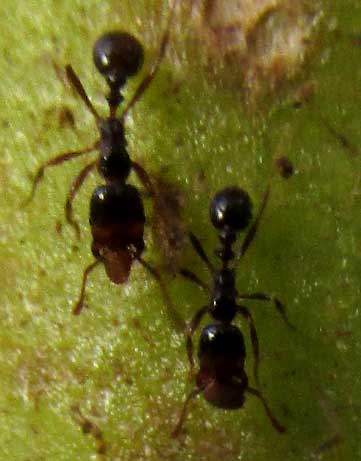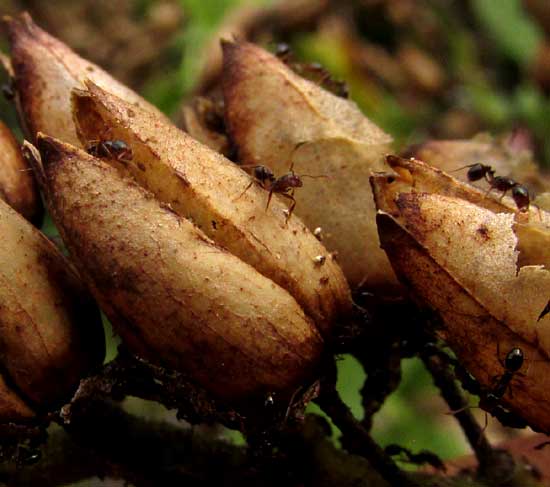Excerpts from Jim Conrad's
Naturalist Newsletter
from the June 28, 2018 Newsletter issued from Rancho Regenesis in the woods ±4kms west of Ek Balam Ruins; elevation ~40m (~130 ft), N~20.876°, W~88.170°; central Yucatán, MÉXICO
SEED-HARVESTING ANTS ON TOBACCO
On Sunday the head-tall tobacco plant had looked as healthy as could be, but the next day all its leaves were drooping and already drying up. The plant's base was turning brown with the epidermis peeling off, as shown below:

Then I noticed a line of tiny black ants ascending and descending the stalk, as shown below:

When I checked in the camera's viewer to see if things were in focus, something interesting turned up. In the above picture, notice that ants descending the stalk are bearing something in their mandibles, but those ascending, aren't. I pushed the camera's macro capabilities a little beyond what the camera was designed for to get a better look at what the ants were carrying. Below, you can see better in the somewhat blurry picture -- and note the ants' curious anatomy, seeming to have more constrictions in its body than normal:

These were unusually small ants, so the brown, oval items being carried were minuscule. Well, tobacco seeds are minuscule, and my suspicions were confirmed by following the line up to the tobacco's fruiting capsules, which were covered with ants as shown below:

Following the ant line downward, I found it entering an opening in the tobacco plant's tissue near the ground -- maybe an opening excavated by the ants themselves, in the process killing the plant -- as shown below:

We've had seed-collecting harvester ants before, up in Texas, so the first step in trying to identify these ants was to check out the taxonomy of harvester ants. It turns out that hundreds of harvester ant species are recognized, and the species are distributed through several genera. Still, we've seen that these ants' anatomy is a bit unusual, with all those constrictions in the abdomen, so maybe an ID was possible.
When pictures of ants in the various harvester-ant genera were consulted, it was noted that two large genera display such anatomy as ours, Aphaenogaster and Pogonomyrmex. I believe ours must be Pogonomyrmex on the grounds that Aphaenogaster ants are described as fairly large, while ours were exceptionally small, plus there's this: Aphaenogaster species have only a single worker caste, but when I checked my photos I found two distinct ant types carrying seeds, as you can verify below:

Therefore, though I can find no Pogonomyrmex species listed for the Yucatan, I'm guessing that that's what we have. As of 2014, 69 species of Pogonomyrmex ants were recognized. Most species occur in deserts throughout the Americas, and I have no idea which species ours could be.
If our ants really are Pogonomyrmex, one interesting fact about that is that Pogonomyrmex workers produce the most toxic venom documented in any insect, a toxicity comparable to cobra venom. While taking the ant-covered-fruit-pods picture I was stung several times and found it surprisingly painful for such a small ant. However, the pain quickly passed and left no lingering effect.
Pogonomyrmex ants are described as digging very deep nests with many underground chambers in which seeds are stored as food for the larvae.